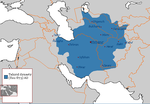Muhammad ibn Ishaq ibn Ibrahim
Muhammad ibn Ishaq ibn Ibrahim | |
|---|---|
| Chief of security (Shurtah) in Baghdad | |
| In office 850 - 851 | |
| Monarch | Al-Mutawakkil |
| Preceded by | Ishaq ibn Ibrahim |
| Succeeded by | Abdallah ibn Ishaq |
| Personal details | |
| Born | unknown date |
| Died | 851 |
| Parent | Ishaq ibn Ibrahim al-Mus'abi |
Muhammad ibn Ishaq ibn Ibrahim (Arabic: محمد بن إسحاق بن إبراهيم, died June 851) was a Mus'abid chief of security of Baghdad for the Abbasid Caliphate, from 850 until his death.
Career[edit]
Muhammad was the son of Ishaq ibn Ibrahim al-Mus'abi, a member of a collateral branch of the Tahirid family and the head of security (shurtah) in Baghdad from 822 to 850. During his father's lifetime Muhammad had been sent to attend the court of the caliph in Samarra, where he entered into the service of the central government and acted as Ishaq's representative.[1]
Upon the death of Ishaq in July 850, Muhammad succeeded him as chief of security of Baghdad; at the same time, by delivering the valuables in Ishaq's storehouses to the caliph al-Mutawakkil and his heirs al-Muntasir and al-Mu'tazz, he secured their favor and was given control over al-Yamamah, al-Bahrayn, Egypt and the Mecca Road as a reward. He also received Fars, but this appointment forced to deal with that province's governor, his uncle Muhammad ibn Ibrahim al-Mus'abi, who adopted a hostile attitude toward him. In response, Muhammad deposed his uncle from his governorship and procured his murder, and appointed his cousin al-Husayn ibn Isma'il al-Mus'abi to govern Fars instead.[2]
Muhammad died in June 851, after which his positions in Baghdad and the Sawad were assigned to 'Abdallah ibn Ishaq ibn Ibrahim.[3]
Notes[edit]
- ^ Daniel 2015; Kraemer 1989, pp. 107–08. The latter adds that Ishaq's decision to send Muhammad to Samarra was prompted by his son's insatiable gluttony, causing him to decide that "[my] money will not suffice to feed [Muhammad's] belly" and that the caliph "can better afford to support [Muhammad] than I."
- ^ Daniel 2015; Kraemer 1989, pp. 105, 107–09; Al-Ya'qubi 1883, pp. 595–96.
- ^ Kraemer 1989, pp. 110, 116; Al-Ya'qubi 1883, p. 596.
References[edit]
- Daniel, Elton L. (27 September 2015). "Taherids". Encyclopædia Iranica. New York. Retrieved 30 November 2015.
- Kraemer, Joel L., ed. (1989). The History of al-Ṭabarī, Volume XXXIV: Incipient Decline: The Caliphates of al-Wāthiq, al-Mutawakkil and al-Muntaṣir, A.D. 841–863/A.H. 227–248. SUNY Series in Near Eastern Studies. Albany, New York: State University of New York Press. ISBN 978-0-88706-874-4.
- Al-Ya'qubi, Ahmad ibn Abu Ya'qub (1883). Houtsma, M. Th. (ed.). Historiae, Vol. 2. Leiden: E. J. Brill.

